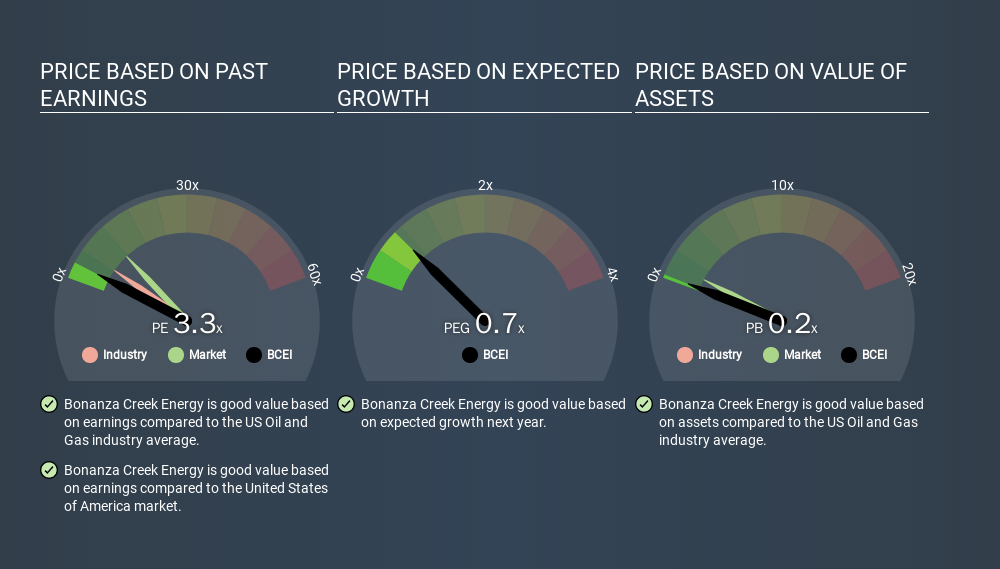Stock Analysis
- United States
- /
- Oil and Gas
- /
- NYSE:CIVI
How Does Bonanza Creek Energy's (NYSE:BCEI) P/E Compare To Its Industry, After The Share Price Drop?

Unfortunately for some shareholders, the Bonanza Creek Energy (NYSE:BCEI) share price has dived 43% in the last thirty days. Indeed the recent decline has arguably caused some bitterness for shareholders who have held through the 51% drop over twelve months.
All else being equal, a share price drop should make a stock more attractive to potential investors. While the market sentiment towards a stock is very changeable, in the long run, the share price will tend to move in the same direction as earnings per share. The implication here is that long term investors have an opportunity when expectations of a company are too low. One way to gauge market expectations of a stock is to look at its Price to Earnings Ratio (PE Ratio). A high P/E implies that investors have high expectations of what a company can achieve compared to a company with a low P/E ratio.
View our latest analysis for Bonanza Creek Energy
How Does Bonanza Creek Energy's P/E Ratio Compare To Its Peers?
We can tell from its P/E ratio of 3.26 that sentiment around Bonanza Creek Energy isn't particularly high. If you look at the image below, you can see Bonanza Creek Energy has a lower P/E than the average (6.4) in the oil and gas industry classification.

Its relatively low P/E ratio indicates that Bonanza Creek Energy shareholders think it will struggle to do as well as other companies in its industry classification. Many investors like to buy stocks when the market is pessimistic about their prospects. If you consider the stock interesting, further research is recommended. For example, I often monitor director buying and selling.
How Growth Rates Impact P/E Ratios
Probably the most important factor in determining what P/E a company trades on is the earnings growth. Earnings growth means that in the future the 'E' will be higher. That means even if the current P/E is high, it will reduce over time if the share price stays flat. Then, a lower P/E should attract more buyers, pushing the share price up.
Bonanza Creek Energy's earnings per share fell by 60% in the last twelve months. And over the longer term (5 years) earnings per share have decreased 41% annually. This might lead to muted expectations.
A Limitation: P/E Ratios Ignore Debt and Cash In The Bank
It's important to note that the P/E ratio considers the market capitalization, not the enterprise value. In other words, it does not consider any debt or cash that the company may have on the balance sheet. Theoretically, a business can improve its earnings (and produce a lower P/E in the future) by investing in growth. That means taking on debt (or spending its cash).
Such expenditure might be good or bad, in the long term, but the point here is that the balance sheet is not reflected by this ratio.
Is Debt Impacting Bonanza Creek Energy's P/E?
Net debt is 32% of Bonanza Creek Energy's market cap. You'd want to be aware of this fact, but it doesn't bother us.
The Verdict On Bonanza Creek Energy's P/E Ratio
Bonanza Creek Energy trades on a P/E ratio of 3.3, which is below the US market average of 11.5. The debt levels are not a major concern, but the lack of EPS growth is likely weighing on sentiment. Given Bonanza Creek Energy's P/E ratio has declined from 5.8 to 3.3 in the last month, we know for sure that the market is more worried about the business today, than it was back then. For those who prefer invest in growth, this stock apparently offers limited promise, but the deep value investors may find the pessimism around this stock enticing.
Investors have an opportunity when market expectations about a stock are wrong. If it is underestimating a company, investors can make money by buying and holding the shares until the market corrects itself. So this free visualization of the analyst consensus on future earnings could help you make the right decision about whether to buy, sell, or hold.
Of course, you might find a fantastic investment by looking at a few good candidates. So take a peek at this free list of companies with modest (or no) debt, trading on a P/E below 20.
If you spot an error that warrants correction, please contact the editor at editorial-team@simplywallst.com. This article by Simply Wall St is general in nature. It does not constitute a recommendation to buy or sell any stock, and does not take account of your objectives, or your financial situation. Simply Wall St has no position in the stocks mentioned.
We aim to bring you long-term focused research analysis driven by fundamental data. Note that our analysis may not factor in the latest price-sensitive company announcements or qualitative material. Thank you for reading.
About NYSE:CIVI
Civitas Resources
An exploration and production company, focuses on the acquisition, development, and production of oil and natural gas in the Rocky Mountain region, primarily in the Field of the Denver-Julesburg Basin of Colorado.
Very undervalued average dividend payer.

